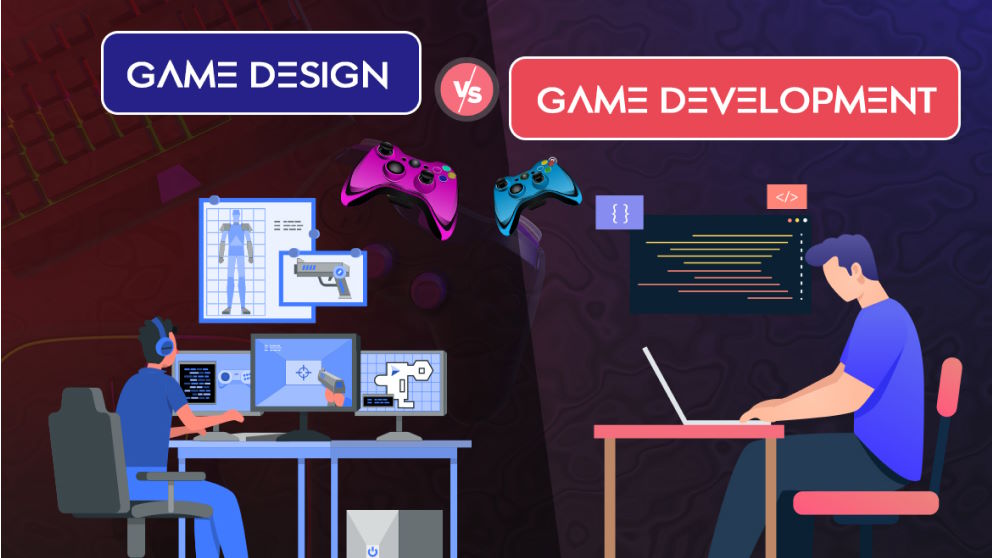Blueprint and C++ in Unreal Engine serve different purposes. This guide breaks down their roles for designers vs. developers, why beginners should start small, and how pros combine them.
Introduction Blueprint vs C++ Unreal Engine
The “Blueprint vs. C++” debate is a common beginner question in Unreal Engine circles. But here’s the truth: they’re not competitors. Blueprints (visual scripting) and C++ (programming) are complementary tools designed for different workflows and roles. Blueprint empowers designers to craft experiences without code, while C++ lets developers build the systems that make those experiences possible. Let’s explore why this distinction matters and how to leverage both effectively.
Game Developers vs. Game Designers: Who Uses What?
Before comparing tools, understand the roles they serve:
- Game Developers (C++): Programmers who build core systems (physics, AI, networking), optimize performance, and create tools for designers. They work “under the hood” of the engine.
- Game Designers (Blueprint): Artists and designers who script gameplay logic, design levels, and prototype ideas without needing to code. They focus on player experience, not engine internals.
C++ is the backbone; Blueprint is the interface. Developers use C++ to create tools, plugins, and frameworks that designers then leverage via Blueprint. For example:
- A developer writes C++ code for a customizable weapon system.
- A designer uses Blueprint to drag-and-drop weapons, tweak stats, and design unique abilities.

Blueprint: The Designer’s Playground
Why Designers Love Blueprints
Blueprints abstract complex code into visual nodes, letting designers:
- Prototype interactions (doors opening, cutscenes triggering).
- Tweak variables (health, speed) in real-time.
- Iterate on gameplay without waiting for a programmer.
The Catch for Beginners
While Blueprints are beginner-friendly, they’re not beginner-proof. Newcomers often hit walls because:
- Overly complex graphs become unreadable (“spaghetti nodes”).
- They lack understanding of programming basics (variables, loops).
Pro Tip for Beginners: Start with small C++ projects (e.g., moving a character) to grasp how Unreal works “under the hood.” This foundation makes Blueprint logic clearer later.
C++: The Developer’s Toolkit
Building the Engine Behind the Experience
C++ isn’t just for AAA studios. Even solo developers use it to:
- Extend Unreal’s functionality: Create custom nodes for Blueprint, plugins, or editor tools.
- Optimize critical systems: Networking, physics, or rendering code.
- Design workflows for others: Example: A tool that auto-generates terrain from a designer’s Blueprint parameters.
Systems That Require C++ (Blueprint Can’t Do This!)
Certain game systems cannot be built in Blueprint due to engine architecture limitations or performance requirements:
1. Replicated Multiplayer Systems
Blueprints can replicate simple variables or events, but complex synchronization (e.g., prediction, rollback, or custom server-authoritative logic) requires C++.
// C++ code snippet for a replicated hit detection function
void AMyCharacter::Server_SendHit_Implementation(AActor* Target, float Damage) {
if (Target->CanBeDamaged()) {
Target->TakeDamage(Damage, FDamageEvent(), GetController(), this);
}
}Blueprint lacks direct access to Unreal’s low-level networking API (UNetDriver, FRepLayout).
2. Custom Character Movement
Unreal’s UCharacterMovementComponent is written in C++. While Blueprints can tweak variables (e.g., gravity, speed), modifying core logic (e.g., custom physics, climb mechanics) requires subclassing in C++.
// Overriding movement logic in C++
void UCustomMovementComponent::PhysCustom(float DeltaTime, int32 Iterations) {
// Custom physics calculations (e.g., wall-running)
Super::PhysCustom(DeltaTime, Iterations);
}When Blueprint Hits a Wall
| System | Why C++ Is Required |
|---|---|
| Custom Network Prediction | Blueprint lacks hooks for reconciling client/server state. |
| Threading (e.g., Async AI) | Blueprint runs on the game thread; C++ can spawn worker threads. |
| Memory Management | Direct control over allocations/optimizations (e.g., object pooling). |
How Pros Use Both Tools
Case Study: Multiplayer Movement
- Developer in C++:
- Subclasses
UCharacterMovementComponentto add server-authoritative wall-climbing. - Implements replication for smooth client-side prediction.
- Subclasses
- Designer in Blueprint:
- Uses the custom movement component to design level-specific abilities (e.g., “ice surfaces reduce friction”).
- Triggers cosmetic effects (particles, sounds) on movement events.
Conclusion: Ditch the “Vs.” Mentality
- For Beginners: Start with C++ basics to understand Unreal’s architecture—it’s the only way to grasp why Blueprint has limits.
- For Pros: Use C++ for engine-critical systems (replication, movement, rendering) and Blueprint for everything else.
Final Takeaway: If your game needs scalability, precision, or custom engine features, C++ isn’t optional—it’s mandatory. Blueprint is the icing; C++ is the cake.
FAQ
Q: Can’t I just use Blueprint for multiplayer?
A: For basic replication (e.g., door states), yes. For competitive games, C++ is unavoidable.
Q: How do I modify the Character Movement Component?
A: Subclass it in C++, override functions like PhysCustom(), then expose variables to Blueprint.
SEO Keywords
Unreal Engine Replication in C++, Custom Character Movement Component, Multiplayer Blueprint Limitations, UE5 Network Prediction, C++ Required Systems
Internal Links

